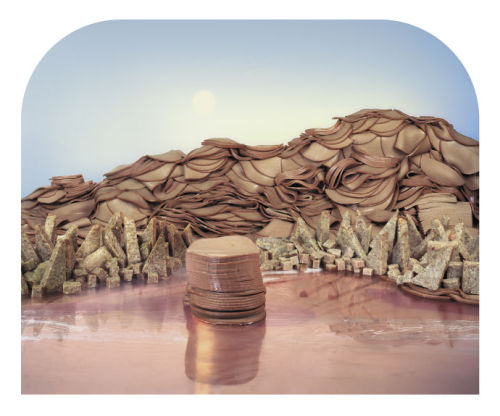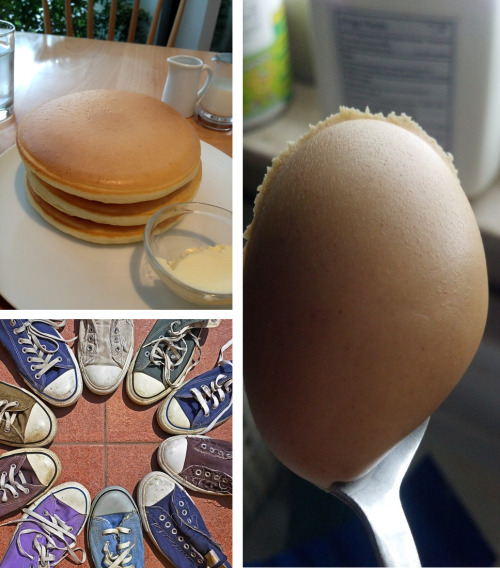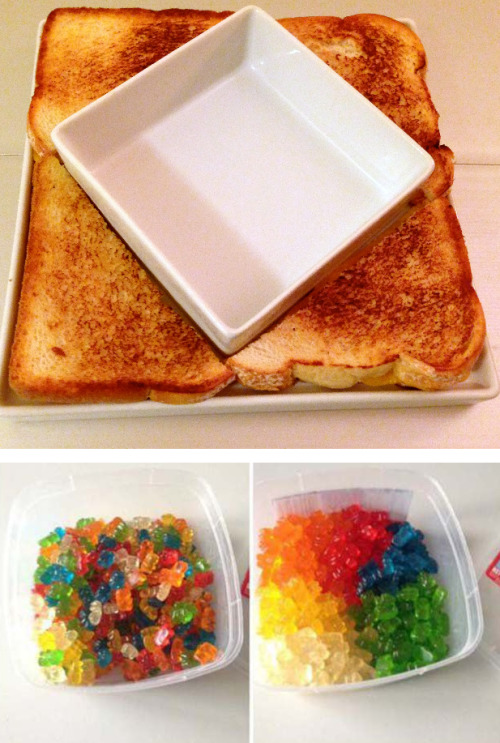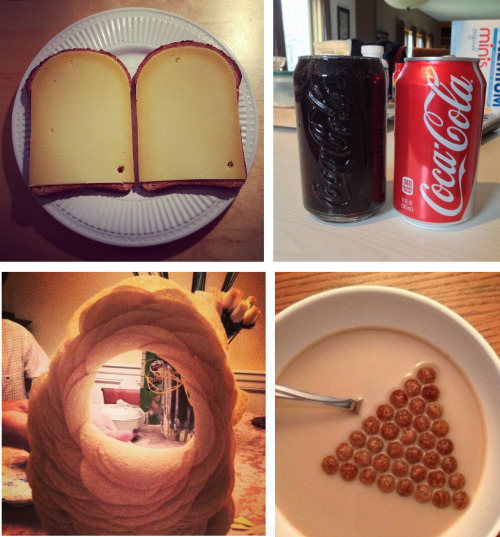Some Random Crystals Formed From My Raw Reaction Mixture At The Bottom Of A Flask.



Some random crystals formed from my raw reaction mixture at the bottom of a flask.
The second at the third is cropped from the original sized picture.
The picture in a large size (3000px wide) could be found HERE, without watermark. Use it as a wallpaper or print it out and put it on your wall. Other pictures from the best posts could be purchased at Society6, now with a free worldwide shipping over here: https://society6.com/labphoto?promo=NJYKQ8VB9QKT
More Posts from Secretagentpeptidebond and Others



Iconic American Landscape Photos, Recreated with Junk Food
For their project “Processed Views,” which is currently on view in the exhibit “Changing Circumstances” at the FotoFest 2016 Biennial, the collaborators Barbara Ciurej and Lindsay Lochman have produced cheeky dioramas that pull Carleton Watkins’s iconic images brashly into the industrial modern world. Using all manner of highly processed foods—Flamin’ Hot Cheetos, Coca-Cola, marshmallows, fleshy stacks of bologna—they recreated the photographer’s famous landscapes from Yosemite and other California sites as garish candy lands.
See more from this processed-food world.
@ultrainfinitequest
In his classic tale Journey to the Center of the Earth, author Jules Verne dreamed of reaching the center of our planet through volcanic tubes. In the 1960s, scientists took up that challenge and tried to drill down into the earth’s mantle, but abandoned the project due to a lack of funding. Now, a team of scientists aboard the research vessel JOIDES Resolution is working to bore a hole deep into the Atlantis Bank in the Indian Ocean to collect samples of the crust and eventually break through into the mantle. Geologist Henry Dick, co-chief scientist of the expedition, joins Ira for an update on the progress of the project and explains what these samples could reveal about the formation of the planet.


In this video lichtenburg figures are burned into wood using a microwave oven transformer. The results are spectacular. (Video) Facebook | Instagram | Scary Story Site
@sheck on Instagram. 💫🌱


The Academy Awards won by scientists
Did you know there is another set of Oscars devoted to the scientific side of movie making?
Two weeks before the televised Oscars, the Academy of Motion Picture Arts and Sciences gives out awards to the innovators who make blockbusters like “The Martian” or “Mad Max: Fury Road” possible.
Combining style *AND* brains, the Scientific and Technical Awards ceremony celebrates technological innovations ranging from camera rigs to software systems to inflatable green screens.
This year’s recipients included Michael John Keesling, who developed the Image Shake, a remote-controlled lens attachment that creates a jerky, hand-held look without shaking the camera. The tool has been used in movies like “Saving Private Ryan” and the Jason Bourne films to create a gritty, “real” aesthetic seen in a lot of contemporary action thrillers.

Brian McLean and Martin Meunier won an award for pioneering the use of rapid prototyping, a process that allows animators to quickly and exponentially produce replacement puppet parts for stop-motion films like “Coraline.”

Past winners of the awards have also included academics.
UC Santa Barbara’s computer science professor, Theodore Kim, won a technical achievement award for creating an algorithm that helps simulate realistic smoke and fire effects seen in dozens of movies, including “Super 8″ and “Avatar.”
Curious about the science behind these effects? Check out the video below:
-
 perniciousoccult reblogged this · 6 years ago
perniciousoccult reblogged this · 6 years ago -
 glitter2133-blog liked this · 8 years ago
glitter2133-blog liked this · 8 years ago -
 imsant reblogged this · 8 years ago
imsant reblogged this · 8 years ago -
 realprotectivewmysoul liked this · 8 years ago
realprotectivewmysoul liked this · 8 years ago -
 amoraticring reblogged this · 9 years ago
amoraticring reblogged this · 9 years ago -
 worthwhile-mess liked this · 9 years ago
worthwhile-mess liked this · 9 years ago -
 beastof2backs reblogged this · 9 years ago
beastof2backs reblogged this · 9 years ago -
 beastof2backs liked this · 9 years ago
beastof2backs liked this · 9 years ago -
 myticme-blog reblogged this · 9 years ago
myticme-blog reblogged this · 9 years ago -
 chuertagar liked this · 9 years ago
chuertagar liked this · 9 years ago -
 randomishnish liked this · 9 years ago
randomishnish liked this · 9 years ago -
 waves-master-blog liked this · 9 years ago
waves-master-blog liked this · 9 years ago -
 fractal-paradise reblogged this · 9 years ago
fractal-paradise reblogged this · 9 years ago -
 arytha reblogged this · 9 years ago
arytha reblogged this · 9 years ago -
 swg459-blog liked this · 9 years ago
swg459-blog liked this · 9 years ago -
 pixielatedreams liked this · 9 years ago
pixielatedreams liked this · 9 years ago -
 simplerhymescheme liked this · 9 years ago
simplerhymescheme liked this · 9 years ago -
 somewhere--in---time reblogged this · 9 years ago
somewhere--in---time reblogged this · 9 years ago -
 lena-octired liked this · 9 years ago
lena-octired liked this · 9 years ago -
 sasshisu liked this · 9 years ago
sasshisu liked this · 9 years ago -
 themolecularbiologist liked this · 9 years ago
themolecularbiologist liked this · 9 years ago -
 wongkar-wife-blog liked this · 9 years ago
wongkar-wife-blog liked this · 9 years ago -
 holistiqallysweet liked this · 9 years ago
holistiqallysweet liked this · 9 years ago -
 aestheticswitch-blog liked this · 9 years ago
aestheticswitch-blog liked this · 9 years ago -
 lovetoheadbang liked this · 9 years ago
lovetoheadbang liked this · 9 years ago -
 ren--renn liked this · 9 years ago
ren--renn liked this · 9 years ago -
 study-early reblogged this · 9 years ago
study-early reblogged this · 9 years ago -
 yougottadrinkcristal liked this · 9 years ago
yougottadrinkcristal liked this · 9 years ago -
 jeanblanc reblogged this · 9 years ago
jeanblanc reblogged this · 9 years ago -
 zinedm liked this · 9 years ago
zinedm liked this · 9 years ago -
 scienceismyaesthetic reblogged this · 9 years ago
scienceismyaesthetic reblogged this · 9 years ago -
 smarms liked this · 9 years ago
smarms liked this · 9 years ago -
 nicholasaurus-blog reblogged this · 9 years ago
nicholasaurus-blog reblogged this · 9 years ago -
 secretagentpeptidebond reblogged this · 9 years ago
secretagentpeptidebond reblogged this · 9 years ago -
 unearthedgemstones liked this · 9 years ago
unearthedgemstones liked this · 9 years ago -
 amysontherun reblogged this · 9 years ago
amysontherun reblogged this · 9 years ago -
 onlyobeythedaleks reblogged this · 9 years ago
onlyobeythedaleks reblogged this · 9 years ago -
 lostlightsperceptor reblogged this · 9 years ago
lostlightsperceptor reblogged this · 9 years ago -
 autobotministerofscience-blog liked this · 9 years ago
autobotministerofscience-blog liked this · 9 years ago



















